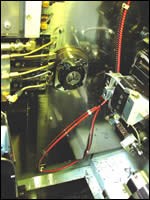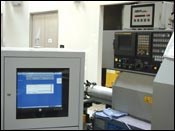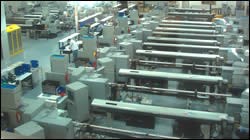Protecting Capital Equipment
"The Atam," as this shop refers to the device, is designed to perform machine diagnostics and real-time, in-process tool action monitoring. The process analyzer from Atam Systems (New Albany, Ohio) is a relatively simple tool.
Often the best way to know what your customer wants is to have been a customer yourself—to have experience in a certain line of work and have first-hand knowledge of what issues are faced and what products could make the job easier. Some of the best product ideas come from creative minded individuals on the front line who step back and think, “What if?”
Some prime examples of such innovation come from a dental implant manufacturer in Calabasas Hills, California. Implant Direct LLC, was formed in 2004 by Dr. Gerald Niznick, a prosthodontist with more than 35 years of practical experience and 25 U.S. patents in dental implant technology. Prior to founding this company, Dr. Niznick had owned and operated another implant design and engineering firm for 19 years. His knowledge of the needs of implant engineering and his desire to do what it takes to be on the leading edge of technology have allowed Implant Direct to become a top supplier for dentists worldwide. His reputation has earned him the nickname “the godfather of American implant dentistry" according to Barrons business magazine.
Going hand-in-hand with Dr. Niznick’s state-of-the-art approach to implant development is his philosophy for implementing advanced manufacturing technology. In preparing to build the company’s current facility, he carefully plotted out the entire shop floor. During construction, the floors were trenched to allow all electrical wiring to be located underground. Dr. Niznick continues to consult with the company’s engineers to determine what strategies will benefit the operation. According to Joe Morales, director of manufacturing at Implant Direct, “When he knows something will work, he’ll spend the money and time to make it happen.” One notable piece of technology effectively at work at Implant Direct is a monitoring device that is installed on every machine on the floor, including a line-up of 26 Star Swiss-type turning centers and a Walter CNC tool grinder.
“The Atam,” as Mr. Morales refers to the device, is designed to perform machine diagnostics and real-time, in-process tool action monitoring. The process analyzer from Atam Systems (New Albany, Ohio) is a relatively simple tool. One vibration sensor is attached to the machine’s turret and one is attached to the gang tool plate. All vibration in the turret is measured. Next to the machine is a PC that records a separate fingerprint, or signature, sent from the Atam for each process, such as ID threading, OD threading or ID center drilling. According to Mr. Morales, “It might take 20 processes to make a part. Each process will have its own unique signature that we want to match to be sure that the machine is running at its optimum and that it has good parts coming off of it.”
Limits are set to correspond with each signature and the Atam is programmed to know where the vibrations should be. If a limit is hit, the system shuts down the machine within as little as 3 milliseconds. “Shutting down the machine, alone, could save us thousands of dollars,” Mr. Morales explains. “In a shop like this, without the Atam, someone could break a turret full of tools daily. We have ten or 12 tools going in the machine, and if the first or second one breaks, the rest of them could follow and all could be gone. Assuming that’s all you lose, you still need someone to go over and reset all of the tools, and then the quality department would need to inspect the part. It might take you out of operation for 4 hours, or if it happens on second shift, you might be down until morning.”
In addition to replacing and resetting the tools, an important consideration is the time involved in determining the reason for the breakage. If the break is not caught immediately, by the time the part cycles through and all the other tools are gone, pinpointing the problem to prevent it from happening again becomes a major issue. The Atam stops the machine immediately after the break and archives the data. A 30-second window, graphed in 3-second increments, is captured to display the activity during the spike.
Implant Direct previously considered the Atam as a tool to be used only for longer runs, typically approaching 10,000 pieces. The setup time involved in defining signatures seemed to dictate the system’s usefulness for particular jobs. And of course, the likelihood of a problem decreased as the runs got shorter. Every morning, employees from various departments including programming, tooling, setup and sometimes quality, get together for an “Atam meeting” to discuss ways to increase productivity and performance of the machines. Over time, through teamwork and brainstorming, the group has found ways to make efficient use of the system on part runs as small as 500. “We may be running a job of only a few hundred pieces, but then it’s followed by ten more runs from the same family of parts,” Mr. Morales explains. “In that case, the signature doesn’t really change much. Only a couple of parameters, for length and time, need to be adjusted.”
Mr. Morales views teamwork and the cutting-edge philosophy that Dr. Niznick has fostered in the company as the key to its success. “When we began discussions about building this facility, we proposed to Dr. Niznick the use of the Atam systems. His willingness to listen and implement our recommendations, in this case and others, has been very rewarding for the
company."
Related Content
Software Controls Chip Breaking in Thread Turning Operations
This cutting tool manufacturer has developed a software module for chip control of thread turning operations in virtually any CNC lathe, even for older machines, using specific tooling and software.
Read MoreLone Shop Machinist Benefits From Five-Axis CAM Modules
This California shop owner applies five-axis strategies for more efficient milling of parts with challenging geometries, free-form surfaces and deep cavities.
Read MoreAvoid the 7 Deadly Sins of Manufacturing
Identifying and preventing these manufacturing sins will reduce or eliminate unnecessary waste, improve efficiency and productivity as well as protect profitability and cash flow.
Read MoreStandard Control Functions with Swiss-Types in Mind
Features in this line of machine-specific CNCs assist setups, offer synchronized movement commands and provide other standard, not optional, capabilities to streamline Swiss-type programming.
Read MoreRead Next
Can You Afford To Ignore Tool Monitoring?
In production, eliminating variability is the key to making good parts consistently. Cutting tool condition is a critical variable in the process. With a return on investment, in many cases, of less than a month, in-process tool monitoring is a cost-effective way to help plan and verify a shop's cutting tool strategy.
Read MoreDo You Have Single Points of Failure?
Plans need to be in place before a catastrophic event occurs.
Read MoreA Tooling Workshop Worth a Visit
Marubeni Citizen-Cincom’s tooling and accessory workshop offers a chance to learn more about ancillary devices that can boost machining efficiency and capability.
Read More















.jpg;maxWidth=300;quality=90)










